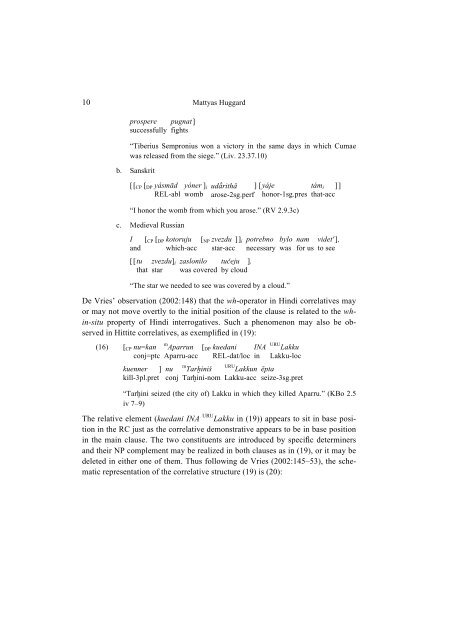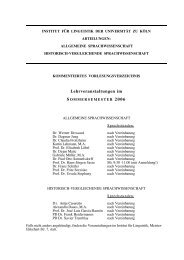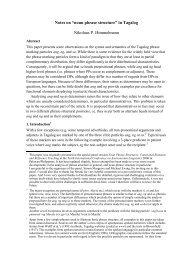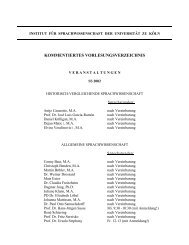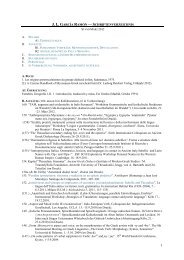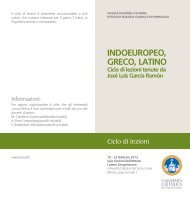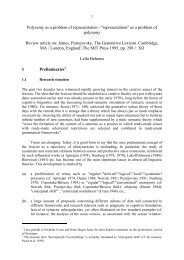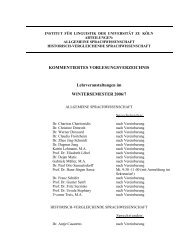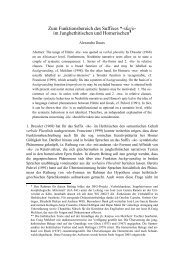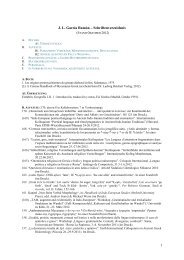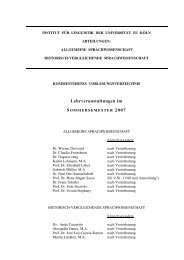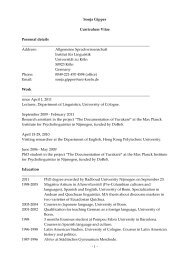Topics in Anatolian Historical Grammar Prof. Dr. H. Craig Melchert
Topics in Anatolian Historical Grammar Prof. Dr. H. Craig Melchert
Topics in Anatolian Historical Grammar Prof. Dr. H. Craig Melchert
You also want an ePaper? Increase the reach of your titles
YUMPU automatically turns print PDFs into web optimized ePapers that Google loves.
10<br />
Mattyas Huggard<br />
prospere<br />
successfully<br />
pugnat]<br />
fights<br />
“Tiberius Sempronius won a victory <strong>in</strong> the same days <strong>in</strong> which Cumae<br />
was released from the siege.” (Liv. 23.37.10)<br />
b. Sanskrit<br />
[[ CP [ DP yásmd<br />
REL-abl<br />
yóner ] i udrith ] [yáje<br />
womb arose-2sg.perf honor-1sg.pres<br />
“I honor the womb from which you arose.” (RV 2.9.3c)<br />
c. Medieval Russian<br />
I<br />
and<br />
[[tu<br />
that<br />
[ CP [ DP kotoruju<br />
which-acc<br />
zvezdu] i zaslonilo<br />
star was covered<br />
[ NP zvezdu ]] i potrebno<br />
star-acc necessary<br />
tueju ].<br />
by cloud<br />
bylo<br />
was<br />
nam<br />
for us<br />
tám i ]]<br />
that-acc<br />
videt ]‚<br />
to see<br />
“The star we needed to see was covered by a cloud.”<br />
De Vries’ observation (2002:148) that the wh-operator <strong>in</strong> H<strong>in</strong>di correlatives may<br />
or may not move overtly to the <strong>in</strong>itial position of the clause is related to the wh<strong>in</strong>-situ<br />
property of H<strong>in</strong>di <strong>in</strong>terrogatives. Such a phenomenon may also be observed<br />
<strong>in</strong> Hittite correlatives, as exemplified <strong>in</strong> (19):<br />
(16) [ CP nu=kan<br />
conj=ptc<br />
kuenner ] nu<br />
kill-3pl.pret conj<br />
m Aparrun<br />
Aparru-acc<br />
m Tar<strong>in</strong>i<br />
Tar<strong>in</strong>i-nom<br />
[ DP kuedani<br />
REL-dat/loc<br />
URU Lakkun<br />
Lakku-acc<br />
INA<br />
<strong>in</strong><br />
URU Lakku<br />
Lakku-loc<br />
pta<br />
seize-3sg.pret<br />
“Tar<strong>in</strong>i seized (the city of) Lakku <strong>in</strong> which they killed Aparru.” (KBo 2.5<br />
iv 7–9)<br />
The relative element (kuedani INA URU Lakku <strong>in</strong> (19)) appears to sit <strong>in</strong> base position<br />
<strong>in</strong> the RC just as the correlative demonstrative appears to be <strong>in</strong> base position<br />
<strong>in</strong> the ma<strong>in</strong> clause. The two constituents are <strong>in</strong>troduced by specific determ<strong>in</strong>ers<br />
and their NP complement may be realized <strong>in</strong> both clauses as <strong>in</strong> (19), or it may be<br />
deleted <strong>in</strong> either one of them. Thus follow<strong>in</strong>g de Vries (2002:145–53), the schematic<br />
representation of the correlative structure (19) is (20):


